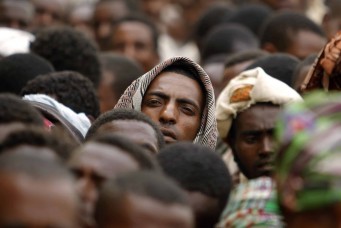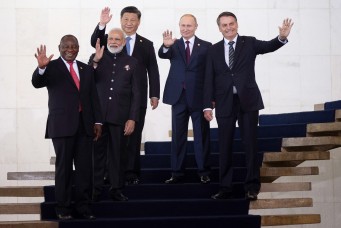The Global South’s New Migration
The issue of migration cannot, and should not be handled bilaterally between the Global North and Global South. What is needed instead is a focus on South-South relations to improve the lives of all people involved in migration.

Fatou Kine works on a customer’s order on a sewing machine purchased with money from the International Organization for Migration (IOM) in her shop in Guediawaye, Senegal April 16, 2018. Mikal McAllister/Reuters
In the twenty-first century, the world has come to a crossroads economically, politically, and demographically. We are facing, more than ever before, an economic divide. The shifts in direction of migration within and between countries of the Global South and North have deepened due to globalization, economic crisis, remittance flows, and the growing significance of emerging market economies to the extent that the real numbers of South-South migration now outpace South-North migration. Many more countries than ever before operate simultaneously as origin, transit, destination and return for migration.
As economic and political processes evolve, the major challenge is how to make migration work productively for all involved: the migrants themselves, their origin and destination countries and the migrants’ societies and families. Partly for this reason, policy dialogue on migration is at a crossroads, not least because the interests of the diverse actors and stakeholders—and of a large variety of interest groups—may well be in conflict. In poor countries and in rich, economic, political and demographic factors underpin the current debate on migration of both skilled and unskilled persons.
Changing Migration Dynamics
The most visible manifestation of change in global migration flows today is the intensification of South-South migration, to the extent that in 2016 South-South migration outpaced South-North, amounting to 38 percent and 34 percent of total migration respectively. This shows us that demographically the world is changing. In 2001 the world’s population reached the landmark 7 billion. Almost 82 percent of this was in the countries of the Global South, mostly in poor countries, such as Malaysia, Indonesia, Pakistan, Bangladesh, Nigeria, whose populations stand at roughly 150 million per country and are still growing. Their youth populations are ready and willing to do any job, anywhere, anytime.
While the G9 countries used to be the most prosperous in the world, these countries are now going through stages of economic decline. Meanwhile two other blocs are emerging: the BRICS (Brazil, India, China and South Africa) and CIVETS (Colombia, Indonesia, Vietnam, Egypt, Turkey and South Africa). Economic blocks like BRICS and CIVETS are the future of world economic development. These are almost all countries in the South, which have young populations and rapid population and economic growth, coupled with generally stable economies, low inflation and low debt. As such, population growth and migration will likely be directed toward these Southern economic nodes in the coming years.
According to the World Bank, of all estimated global remittance flows in 2015, India ($72.2bn), China ($63.9bn), Mexico ($25.7.6bn), the Philippines ($29.7bn), Nigeria ($20.8bn) and Egypt ($20.4bn) topped the list of receiving countries. Over the last five years, remittance values have risen steeply in many poor countries and in some now parallel export earnings or overseas development assistance. Yet, transaction costs for South-South remittances are higher than for North-South and much higher than for North-North, which erodes a substantial proportion of remittances going to the Global South.
Changing the Discourse on Migration
A number of key changes have catapulted migration into our modern public discourse. The biggest change has occurred over the last 20 years. The 9/11 attacks in the United States reshaped the configuration of migration to include a strong emphasis on security. Human mobility, as we all know, is now subject to significantly stricter controls, more so under the present United States administration.
Migration is a significant aspect of international economic management as well as an important component of international trade relations. As globalization deepens and intensifies, the challenge is to maximize the opportunities that migration affords, and minimize its negative aspects.
While many countries in the North have been receiving substantial numbers of migrants over a period of many years and are no longer capable of absorbing more, it is also obvious that tight immigration policies breed irregular immigration. Hence, the success of restrictive migration policies depends first and foremost on improving the economic situation in immigrants’ countries of origin, addressing the so-called “root causes” of migration. Such a strategy could also stimulate the return of skilled nationals needed for social transformation in their countries.
Challenges and Recommendations
Rich and poor countries have divergent migration needs, which have prompted the former to rethink and consolidate policies on who should be attracted and admitted to satisfy their skilled labor shortages. For poor origin countries the loss of specialists in IT, engineering and medicine, while a miniscule proportion of the workforce, has had an outsized negative impact.
Globalization means increased integration, among countries, of markets for goods, services, capital, and information. This is sustained by the liberalization of economic policies and the removal of cross-border impediments. Global markets, global resources, global ideas and global solidarity can—or at least should—enrich the lives of people everywhere. However, the new interdependence works for profits rather than for people, and benefits are not shared equitably.
The persistent clamor by the South for a just trade regime is driven by the debilitating effects of the unfair trade tariff regimes set by rich countries on agricultural products from the South and their adverse effects on development, job creation and, ultimately, on migration pressure. In some cases tariff regimes have been lowered and free trade promoted, but without a sufficient inflow of foreign direct investment to stimulate job creation, or to have an impact on labor migration. Globalization and liberation then have, for a variety of reasons, not benefited either African countries or the poor Asian and Pacific Island countries.
The 2008 global financial crisis introduced yet another dimension to global migration. The downturn’s effects were felt in emerging market economies, and also in other poor countries. The emerging and fast-growing economies of Brazil, China and India faced economic difficulties, and the speed and depth of the spread of the problem made the poor countries of Africa and Asia vulnerable. Migrant-sending, poor countries, whose economies depend heavily on migrants’ remittances, are the ones that suffered most.
Unlike rich countries, African countries are not yet able to launch robust recovery stimulus plans, which exposes their already poor people to further hardship. For many aid-dependent countries—such as Uganda, Rwanda, Malawi and Senegal—the flow of development aid is declining, as are private capital flows. Meanwhile, African leaders face the challenge of how to retain the rare skills of departed nationals, how to attract them back and effectively utilize them for national development. Given favorable working conditions in their home countries skilled professionals, both men and women, would prefer to remain, and those in diaspora would opt to return. Leaders must now put in place policies to ensure that industries operate at optimum capacity, that they provide an enabling environment for the private sector to thrive, and that they promote democratic governance and popular participation—so that returning nationals can be more effectively inserted into domestic economies. Indeed, as the ongoing global crisis continues to reduce Africa’s options for foreign investment, aid, and technology, as well as the value of primary exports, capital can be re-introduced if enough socially and economically viable members of the diaspora return to their homelands.
A Fundamental Step: Regional Economic Communities
Regional economic communities (RECs) in Africa that exist to govern trade and migration are often dominated by the economies of a single country, and migrants have been directed towards a limited number of countries within these unions. However, these organizations are well positioned to foster dialogue and better management of labor mobility. The African Economic Community, for example, advocates programs that encourage labor mobility within and between African countries, and encourages sustained development. For countries that have hitherto remained ambivalent about the free movement of persons and reluctant to modify domestic laws and administrative practices, now is the time to realign national laws with sub-regional treaties—to facilitate intra-regional labor mobility, establishment and settlement. The lessons learnt from some RECs, such as the Economic Community of West African States (ECOWAS)’ efforts to create a borderless sub-region, need to be replicated by others. Concerted efforts should also be made to promote managed inter-REC labor migration through multilateral agreements built on the effective demand and supply of required skills.
Finally, intra-regional trade within the Global South as a whole remains an abysmally low fraction of total world trade. This South-South trade should be encouraged, to take advantage of its potential for stimulating development, poverty alleviation and job creation. The indirect impact on migration could be tremendous.
Migration is indeed a complex issue. Within migration we have irregular migrants, female migration, student mobility, the migration of highly skilled professionals, asylum seekers and refugees. Consequently, our current imperative is to showcase migration as a positive element of development, and in so doing reshape the discourse surrounding human movement across borders and continents.




